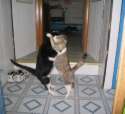

Poisoning can make masses to dance hysterically. Dancing mania is the name given to a phenomenon that occurred mainly in mainland Europe from the 14th century through to the 17th century, in which groups of people would dance through the streets of towns or cities, sometimes foaming at the mouth or speaking in tongues, until they collapsed from exhaustion. The first major outbreak of the mania was in Aachen, Germany, in July 1374. The dancers went through the streets screaming of wild visions, and even continued to writhe and twist after they collapsed from exhaustion. The dancing quickly caught on, and spread rapidly throughout France and the Low Countries. The mania reached its peak in 1418 in Strasbourg. At at least one point, so many people had either been afflicted with the dancing mania, or caught up in the dancing, or were trying to give assistance, or simply watching the events unfold, that the town was brought to a complete halt. Although no real consensus exists as to what caused the mania, some cases, especially the one in Aix-la-Chapelle, may have had an explainable physical cause. The symptoms of the sufferers can be attributed to ergot poisoning, or ergotism, known in the Middle Ages as "St. Anthony's Fire". It is caused by eating rye infected with Claviceps purpurea, a small fungus that contains toxic and psychoactive chemicals (alkaloids), including lysergic acid (used in modern times to synthesize LSD). Symptoms of ergot poisoning include nervous spasms, psychotic delusions, spontaneous abortion, convulsions and gangrene; some dancers claimed to have experienced visions of a religious nature.
Friday, November 10, 2006
Posted by alilbit at 9:36 PM
Subscribe to:
Post Comments (Atom)


0 comments:
Post a Comment